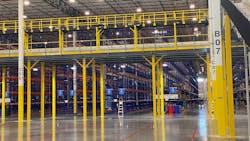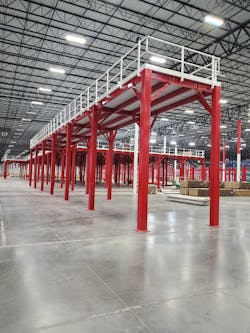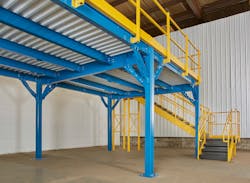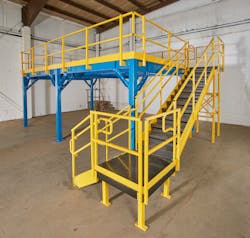Warehouse Storage Expansion: Creating Supply Shock Resilience With Cost Effective Options
Since the pandemic showed manufacturers, distributors, and retailers how supply chain disruptions can cause dramatic shortages of products and materials, many are seeking to increase inventory to avoid similar problems in the future.
However, warehouse space is in short supply, particularly around coastal seaports and distribution centers, with prices rising as leased properties are quickly snapped up.
The recent New York Times story titled “Warehouse Space Is the Latest Thing Being Hoarded” frames the problem this way:
“As retailers and logistics companies try to stockpile goods to hedge against supply chain problems, they are facing a new challenge: In many parts of the United States, there is little to no space available to stash the merchandise. The shortage of commercial warehouse and industrial space is the latest fallout from pandemic-fueled growth in online shopping and shows few signs of abating.”
With storage, logistics, and distribution facilities strained to the limit today, managers are now looking to cost-effectively optimize operations without leasing more space or expanding the building with new construction when they have essentially run out of space.
Fortunately, versatile options are available in the industry that can help to make the most of facility vertical space and storage density. The cumulative effect of taking advantage of some or all of these offerings can substantially improve supply shock resilience in preparation for the next pandemic surge, natural disaster, war, political dispute, or another black swan event.
Leveraging Vertical Cubic Space
As floor space has become increasingly scarce, going up—not out—is an increasingly popular strategy. Companies are evolving from thinking about storage in square foot space, in favor of cubic space. Toward this end, one way to extend the use of existing square footage is with free-standing elevated work platforms, which can essentially double the space in the same square footage.
Elevated work platforms can be utilized to create an additional workspace for small parts storage, picking and sorting operations, archiving, in-plant office space, and more.
Due to the importance of incorporating elevated work platforms into warehousing, Steel King Industries, a national manufacturer of racking and storage systems, created an independently operated business unit, called NexCaliber Structures, focused solely on supplying turnkey solutions for engineered elevated work platforms.
The business unit accelerates engineered work platform projects while minimizing risk in a number of ways.
First, 3D design visualization software technologies are used to quickly determine the most successful solution for the operation, including configuring custom platforms and accessories, reviewing costs, and determining efficient alternatives to the warehouse footprint and workflow.
The project is expedited with accurate quotes and simplified 3D models utilizing automated parametric estimating technology (PET). Assemblies and components are instantly populated from CAD models. The process streamlines approvals with in-house structural and professional engineering. Surprises are eliminated with critical path scheduling. The resulting platforms are designed for complete warehouse integration as well as easy installation.
An example of a platform is the ClereSpan Mezzanine. The mezzanine system can be customized with a variety of floor surfaces, stairs, and gates. Flooring options range from standard roof decking and wood to bar grating. To match facility growth, the platform can be combined with other products to form a full turnkey system. Custom multi-level systems are available as well.
Using precious existing warehouse floor or rack space to store empty pallets can also waste valuable square footage. Once again, better utilizing vertical space can resolve the issue and eliminate a source of clutter which can improve safety as well.
Above the Doors
In this regard, putting unused space to use above the warehouse dock door may be the answer. As a solution to empty pallet storage problems, the Over-Dock Pallet Storage Rack can help warehouse/logistics managers and shipping/receiving supervisors put more products in their warehouse without a bigger building while improving operational efficiency.
Like a cupboard in the kitchen, the racking keeps empty pallets safely out of the way until needed, when they are conveniently at hand in a specially designed over the loading dock storage rack that will accommodate empty pallets, skids or returnable shipping containers. With typically two shelves installed above an average 12-foot wide dock door, almost 100 square feet of additional storage space can be added above each dock door. This frees up floor or rack space for storing higher-value items than empty pallets.
Ultimately, however, to get significantly more effective use out of an existing warehouse or distribution center, increasing the density of storage is required.
Increasing Storage Density
Instead of less efficient traditional techniques like floor stacking and static or selective racks, warehouse managers are increasingly turning to advanced methods, such as pushback pallet rack, which offers up to 90 percent more product storage than selective rack systems and up to 400% more selectivity than drive-in racks.
Unlike static, single-pallet deep selective racks, a dynamic pushback rack system allows storing pallets two to five deep while providing easy access to a variety of different SKUs. Pallets are stored behind each other in a series of nested carts and are loaded from the same side of the system, eliminating separate aisles for each function. Composed of a stable rack along with a series of inclined carts and rails, when one pallet is pulled, the one behind it rolls forward.
To quickly teach forklift operators the key differences between traditional static loads and the dynamic pushback system while avoiding forklift damage or pallet rack damage, warehouse managers are training staff with the help of a free handbook ”Pushback System Safe Operating Procedures User Handbook” provided by Steel King. The pushback safety handbook highlights best practice procedures and illustrates them with easy-to-understand graphics.
However, for maximum pallet rack use in a minimum footprint, along with inventory management capability, a warehouse pallet flow storage system can be the answer. In a pallet flow storage system dynamic flow rails are inclined in a static rack structure. This allows loads placed on one end to move by gravity on rollers to the unloading end, with speed controllers acting as gentle brakes. As a load is removed, the loads behind it move forward automatically.
Once loaded, FIFO product rotation is automatic, and the rack eliminates labor and fork truck operation to arrange loads. Forklifts are required only for the initial and final unloading.
Compared to traditional selective pallet rack use, which requires multiple aisles, aisle space can be reduced by 75% and up to 100% more products can be stored.
Realistically, not every logistics firm, manufacturer, distributor or retailer has the resources to sign deals for new space before ground is broken. So, when reimagining the warehouse space, they occupy becomes the priority, implementing one or several of the options discussed can free up significant storage space in their existing facility.
The net effect of reclaiming this underutilized space can not only improve operational efficiency today but also help to accommodate the inevitable supply chain shocks of the future, whatever the cause.
For a free copy of Steel King’s “Pushback System Safe Operating Procedures User Handbook”, visit https://www.steelking.com/whitepapers-and-guides/pushbackrack/.
For more info call Steel King at (800) 826-0203; visit www.steelking.com or https://nexcaliber.steelking.com
About the Author

Del Williams
Del Williams is a technical writer based in Torrance, California. He writes about health, business, technology, and educational issues and has an M.A. in English from C.S.U. Dominguez Hills.




